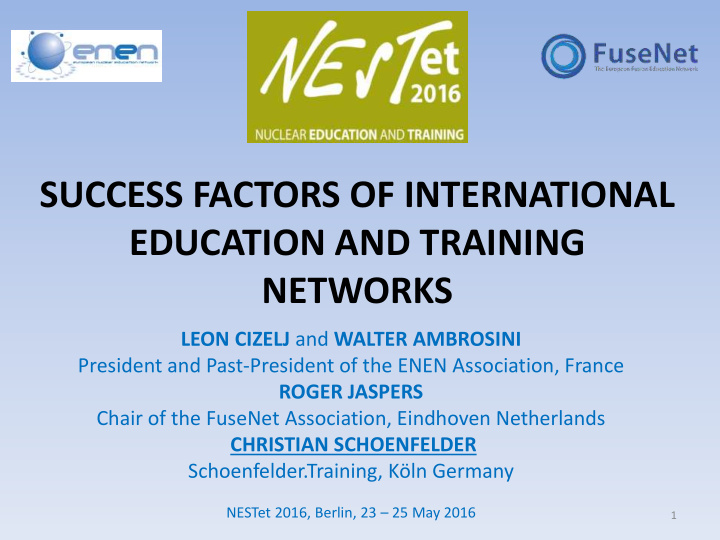



SUCCESS FACTORS OF INTERNATIONAL EDUCATION AND TRAINING NETWORKS LEON CIZELJ and WALTER AMBROSINI President and Past-President of the ENEN Association, France ROGER JASPERS Chair of the FuseNet Association, Eindhoven Netherlands CHRISTIAN SCHOENFELDER Schoenfelder.Training, Köln Germany NESTet 2016, Berlin, 23 – 25 May 2016 1
Why E&T Networks? • Lisbon EU 2000 summit: strategic goal for EU is to become the most competitive knowledge-based economy with more and better employment and social cohesion • Via further harmonization of educational curricula in Europe aiming at facilitating international mobility of the labor work force and enabling lifelong learning paths • At the beginning of the 2000s, different challenges existed: expected shortages of human resources and their competences for – Fission: new built, plant modernization or decommissioning projects – Fusion: the path to fusion power (ITER, DEMO) • Therefore, funded by Framework EC Programs (FP) 5 and 7, the implementation of education and training networks was supported by the European Commission: – ENEN - the European Nuclear Education Network, – FuseNet - the European Fusion Education Network 2 SUCCESS FACTORS OF INTERNATIONAL EDUCATION AND TRAINING NETWORKS
History of Networks • The “European Nuclear Engineering Network” (ENEN) project was launched under FP5 in January 2002 • The European Nuclear Education Network (ENEN) Association was established on 22 September 2003 • The “European Fusion Education Network” (FuseNet) project was launched under FP7 in October 2008 • The “European Fusion Education Network” (FuseNet) Association was founded in December 2010 Benefits of this approach (networks founded on the basis of research and development projects funded by the EU) : • Founding members could develop a common understanding on the mission and objectives of the networks • Tangible results were developed that could then be further used by the new networks • While relying greatly on the personal relationships during the project, international networks of different institutions could be built 3 SUCCESS FACTORS OF INTERNATIONAL EDUCATION AND TRAINING NETWORKS
Target groups and members /1/ • Currently 67 members • Members are public or private corporate bodies that have a legal status: universities, research organizations, nuclear industry, and/or any other organizations involved in the application of nuclear science and ionizing radiation • Members provide academic or professional education and training in the application of nuclear science and ionizing radiation, and/or commit themselves to supporting ENEN • Institutions from Japan, Russia, South Africa, Ukraine are connected to ENEN via MoU 4 SUCCESS FACTORS OF INTERNATIONAL EDUCATION AND TRAINING NETWORKS
Target groups and members /2/ • Currently 59 members • Universities, research organizations, nuclear industry, and/or industrial or other organization members (like the ITER Organization) • FuseNet activities shall address all education levels, from Master and PhD students to Post-docs • Members are distributed nearly homogeneously over the EU 5 SUCCESS FACTORS OF INTERNATIONAL EDUCATION AND TRAINING NETWORKS
Objectives of Networks • The preservation and the further • To stimulate, coordinate and enable development of expertise in the the best possible fusion education in nuclear fields by higher Education and Europe with the aim to enhance the Training by expertise in the fusion area by higher Education and Training – delivering a European MSc degree in nuclear engineering and promote PhD • Students have a central role in the studies, FuseNet view and the student – promoting the exchange of students and support schemes are the most teachers participating in the network, visible and successful activities of – establishing a framework for mutual FuseNet, recognition, The aim: to attract the best students – fostering and strengthening the and stimulate them to have access relationship with research laboratories, to excellent education industry and regulatory bodies. 6 SUCCESS FACTORS OF INTERNATIONAL EDUCATION AND TRAINING NETWORKS
Activities of Networks • Award of • Award of – – European Master of Science in Nuclear European Fusion Master Certificate – Engineering (EMSNE) certificate European Fusion Doctorate Certificate – ENEN PhD Prize • Special events • Special events – In connection with General Assembly – – In connection with General Assembly FuseNet PhD Event – ENEN PhD Event • Work packages funded by EUROfusion • Specific E&T projects, currently – Organization of annual Fusion PhD event – Support to PhD students – ANNETTE – Support to the development of new – NUSHARE educational activities – PETRUS III – Development of Joint Educational Tools – – EUJEP 2 Industry and Training – Consultancy for PhD programs – Support to Master students 7 SUCCESS FACTORS OF INTERNATIONAL EDUCATION AND TRAINING NETWORKS
Network web sites • Information for members • and interested parties (students) • Current E&T offers • Interaction and communication within the network • Access to important documents for members 8 SUCCESS FACTORS OF INTERNATIONAL EDUCATION AND TRAINING NETWORKS
Conclusions Factors that are crucial for the success of networks: 1. Public education and training related activities that provide appropriate diploma or certificates in line with the network’s mission , 2. An effective, up-to-date hub of information and possibly also communication between the members and outsiders, 3. Externally funded projects in which members of the network are involved in, and that develop tangible results to achieve the network’s objectives. Only the last factor will support the long-term operation of an E&T network! 9 SUCCESS FACTORS OF INTERNATIONAL EDUCATION AND TRAINING NETWORKS
Recommend
More recommend